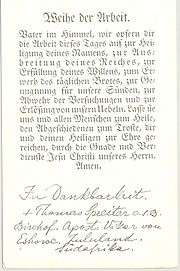Thomas Spreiter
| Thomas Spreiter, OSB | |
|---|---|
| Born |
December 28, 1865 Regensburg, Germany |
| Died |
January 27, 1944 (aged 78) Vryheid, KwaZulu-Natal, South Africa |
| Resting place | Sacred Heart Abbey, Inkamana |
| Nationality | German |
| Occupation | Missionary, bishop |
| Years active | 1900 - 1943 |
| Organization | Ottilien Congregation |
Thomas (Franz Xavier) Spreiter, OSB (28 December 1865 – 27 January 1944)[1] was a German missionary, one of the first of the Missionary Benedictines, who worked in German East Africa and later South Africa. He was the ordinary of the Roman Catholic Archdiocese of Dar-es-Salaam in German East Africa,[2] and bishop of the Apostolic Vicariate of Natal and of the Vicariate of Eshowe.
Biography

Childhood, early education
Thomas Spreiter was born to a deeply religious Catholic middle-class family. From an early age, he had shown an interest in missionary work, but during the Kulturkampf no orders could engage in missionary activities. However, Benedictine visionary Andreas Amrhein had just begin his Ottilien Congregation and had opened up an institute in Reichenbach am Regen, not far from Regensburg. Spreiter began his novitiate there on 29 September 1886. The institute was housed in a former Benedictine monastery, and the first years, poverty reigned and the work was hard; additionally, Spreiter had become Amrhein's personal secretary. In 1887, the order transferred its activities to St. Ottilien Archabbey.[1] There, he professed on 2 February 1888, and was ordained on 28 July 1897.[2]
First mission
In 1900, he left for the mission in Zanzibar,[2] where the Benedictines of St. Ottilien Archabbey had been active after 1888. He headed the mission there in 1905,[3] until the Maji Maji Rebellion, during which Bishop Cassian and four other bishops were killed, threatened his mission and his life; they fled, and Spreiter went to Europe to learn of his future as a missionary.[1]
Second mission
Spreiter, on his return to Europe, learned that he was appointed as apostolic vicar on 13 March 1906,[2] succeeding Bishop Spiss. He was ordained in St. Ottilien on 1 May, and returned to Africa in 1906, now overseeing all missionary and educational activities in his vicariate: "Every year he undertook a pastoral journey through his mission territory. That meant he was on the road for up to six months and covered a distance of around 1500 kilometers on foot."[1]
When World War I broke out, all German missionary activities were forcibly halted, and Spreiter was under house arrest in Dar es Salaam until 1920, when he was made to return to Germany,[1] "resigning" his post in Zanzibar on 24 November 1920.[4]
Third mission
On 27 August 1921 he was appointed as bishop (1st Apostolic Prefect[1]) to the Apostolic Vicariate of Natal (Zululand).[5] In 1922, with the help of other German missionaries, he founded the Inkamana Abbey, also known as Sacred Heart Abbey, Inkamana.[1] Three years later, on 26 January 1924, he was nominated 1st Apostolic Vicar of the newly promoted Vicariate of Eshowe,[1] which had split off from the Apostolic Vicariate of Natal in 1921. He was described as "rigid and uncompromising."[6] He retired on 14 May 1943, and died in Sacred Heart Abbey, on 27 January 1944, where he is buried.[7]
Dinosaur bones
During Spreiter's tenure in Zanzibar, Werner Janensch and Edwin Hennig were conducting their expedition to the Tendaguru Formation. On May 30, 1910, Spreiter visited their camp, where Hennig met him. Spreiter showed him a bone fragment he had picked up in a village near the Mbalawala Plateau, and another fragment he had found in a village called Makangaga, west of Kilwa Kivinje, which proved that dinosaur bones could be found hundreds of miles from Tendaguru, the initial aim of their expedition.[8]
References
Notes
- 1 2 3 4 5 6 7 8 Sieber, Godfrey (2003). "Thomas Spreiter (1865–1944), Bischof in Ostafrika (1906–1920) und Südafrika (1921–1944)". In Godfrey Sieber and Cyrill Schäfer. Beständigkeit und Sendung:Festschrift St. Ottilien 2003. EOS Verlag. pp. 345–50. Retrieved 16 December 2010.
- 1 2 3 4 Herbermann, Charles George; Edward A. Pace; John Joseph Wynne; Andrew Alphonsus MacErlean (1914). The Catholic Encyclopedia: An International Work of Reference on the Constitution, Doctrine,discipline,and History of the Catholic Church. R. Appleton. p. 85. Retrieved 16 December 2010.
- ↑ Ludwig, Frieder (1999). Church and state in Tanzania: aspects of changing relationships, 1961-1994. Brill. p. 23. ISBN 978-90-04-11506-4.
- ↑ Cheney, David M. "Archdiocese of Dar-es-Salaam". Retrieved 16 December 2010.
- ↑ Denis, Philippe (1998). The Dominican friars in Southern Africa: a social history, 1577-1990. Brill. p. 151. ISBN 978-90-04-11144-8.
- ↑ Sieber (1995) 389.
- ↑ Sieber (1995) 387.
- ↑ Meier, Gerhard (2003). African dinosaurs unearthed: the Tendaguru expeditions. Indiana UP. p. 55. ISBN 978-0-253-34214-0.
Bibliography
- Sieber, Godfrey (1995). The Benedictines of Inkamana. EOS Verlag. ISBN 978-3-88096-480-8.
